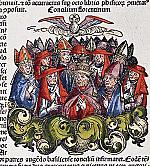Last at the cross, first at the tomb

[Saint Catherine of Alexandria woodcut with hand-colouring, circa 1470-80.jpg Christies / public domain, Wikimedia.]
What do our editors love? Finding the stories that energize and interest you! Historical accounts of women in the church are among our top-searched content online. Here is just one piece of that larger story.
Celsus, a second-century detractor of the faith, once mockingly said the church attracted only “the silly and the mean and the stupid, with women and children.” His contemporary, Bishop Cyprian, acknowledged that “Christian maidens were very numerous” and it was hard to find Christian husbands for them all. Women, it seemed, disproportionately populated the church.
One reason why might have been the Roman practice of exposing unwanted female infants—abandoning them to certain death. Christians repudiated this practice. Also, in the upper echelons of society, women often converted to Christianity while their male relatives remained pagans lest they lose their senatorial status.
“Fellow ministers”
Sources attest to women’s involvement in the church’s first few decades. Many served as house church leaders, including Priscilla, Chloe, Lydia, Apphia, Nympha, and the mother of John Mark.
Clement of Alexandria (c. 150–c. 215) wrote that women accompanied the apostles on their missionary journeys, not as marriage partners but as colleagues, “that they might be their fellow ministers in dealing with housewives. Through them the Lord’s teaching penetrated also the women’s quarters without any scandal being aroused.”
Was that the role of Junia? Paul mentions her in Romans 16 as “of note among the apostles.” Some have debated the verse’s meaning, but early tradition holds that Junia was a woman and considered an apostle. John Chrysostom (347–407) wrote:
Indeed, to be an apostle at all is a great thing; but to be even amongst those of note; just consider what a great encomium that is. . . . Oh, how great is the devotion of this woman, that she should even be counted worthy of the appellation of apostle.
Paul also mentions Phoebe in Romans 16, “a deacon of the church at Cenchreae.” He calls her a prostatis or overseer. Apostolic fathers later used this term in its masculine form (prostates) to designate the one presiding over the Eucharist. The church in Rome is asked to welcome her and assist her in the church’s business.
Philip’s four daughters appear in Acts 21:9 as prophetesses. Eusebius viewed them as “belonging to the first stage of apostolic succession.” Polycarp mentioned the sister of Crescens, who deserved special commendation when delivering the letter in Philippi. The Shepherd of Hermas, written about 148, gives instructions to make two copies of the work, giving one to Grapte, “who shall exhort the widows and orphans.” The other copy went to Bishop Clement. Grapte and Clement appear to represent the female and male leaders respectively.
Legends or Histories?
Certain female leaders are described as fully historic personages, while others are embedded in legend. Catherine of Alexandria, for instance, reportedly lived in the second century. The patron saint of scholars and philosophers, she allegedly debated 50 philosophers and won them all to Christ. She was condemned to death on the wheel. Her story may have been adapted from the actual story of Hypatia, a pagan philosopher killed by an enraged Christian mob.
St. Thecla’s legend is the best known of numerous apocryphal stories. A noblewoman, she was converted while listening to Paul’s preaching. She followed the apostle and endured persecution, tribulation, and peril. After itinerating through Asia Minor with Paul, she settled near Seleucia, where she preached, healed, and baptized. The story is probably fictitious or at least embellished, but Thecla most likely existed.
Women were the last disciples at the cross and the first at the empty tomb. They remained integral to the church’s work in its early centuries. In the Roman catacombs, images show women in authoritative stances, hands raised in a bishop’s posture, dominating the scene. Their steadfast faith and ministry still bless us. —Catherine Kroeger (1925–2011), from CH #17
By Catherine Kroeger
[Christian History originally published this article in Christian History Issue #150 in 2024]
Catherine Kroeger (1925–2011) was an American writer, professor, and New Testament scholar.Next articles
The emperor, the healer, and the teacher
Constantine, Basil, Augustine
David F. Wright, Timothy S. Miller, Dan GravesConquests and convents, division and dung
Expanding Christendom, if necessary by force, had become part of a king’s duty.
G. R. Evans, Ann K. Warren, George T. Dennis, Daniel V. RunyonSupport us
Christian History Institute (CHI) is a non-profit Pennsylvania corporation founded in 1982. Your donations support the continuation of this ministry
Donate







